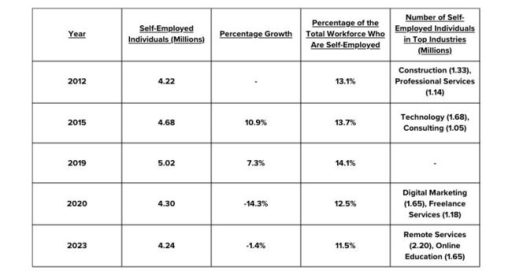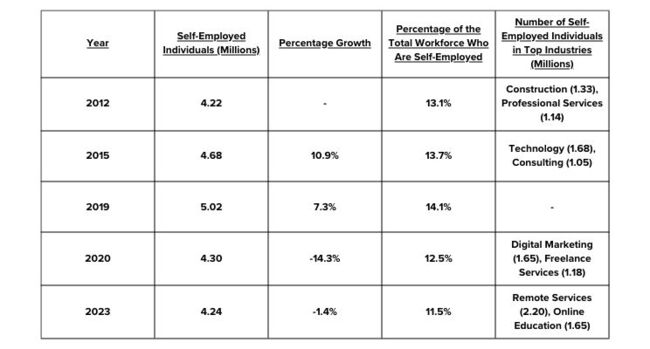Recent figures highlight the smallest proportion of the UK’s workforce being self-employed in almost 20 years, marking a significant decline. Since the onset of the COVID-19 pandemic, there’s been a 15.5% reduction in the number of self-employed people in the UK. Currently, 2.2 million self-employed Britons are working remotely, reflecting a broader trend towards remote work.
A recent study on the UK’s employment scene reveals a significant drop in the number of self-employed individuals since the COVID-19 pandemic began.
The research conducted by Business Coach Academy indicates that self-employment rates are nearing their lowest in ten years, with the current percentage of self-employed individuals in the UK workforce at its lowest in nearly two decades. The study also highlights shifts in the leading sectors for self-employment, mirroring the recent tumultuous events.
The zenith of self-employment in the UK was witnessed at the end of 2019, boasting over 5 million self-employed individuals, which represented 14.1% of the entire UK workforce.
The year 2020 experienced a drastic reduction in self-employment numbers, with nearly a 15% decline attributed primarily to the COVID-19 pandemic, leading to the closure of approximately 400,000 UK enterprises within a year.
The figures for self-employment have not only failed to rebound to pre-pandemic levels but have seen further decline into 2024. Although there was a minor resurgence in 2022, it was swiftly offset by subsequent economic and geopolitical instabilities.
Zander Woodford-Smith, the founder of Business Coach Academy, commented, “A lot of this is to be expected. Of course the events over the last few years have had a terrible impact on small businesses in the UK. But the data also shows that now is a great time to become self-employed. The competition is dwindling, and you have a chance to get in early before the self-employment landscape makes a full recovery.”
Moreover, there has been a significant yet gradual shift in the distribution of self-employed individuals across various sectors. In 2012, the construction sector dominated the self-employed segment with over 1.3 million individuals. However, post-2020 and especially after the COVID-19 pandemic, there’s been a pivot towards sectors like digital marketing, remote services, and online education, showcasing the resilience and adaptability of UK enterprises.
“It’s difficult to say what the future of self-employment in the UK will look like. There’s been little sign of recovery. But while the numbers of self-employed persons may have decreased, people are adapting, shifting more towards the realms of digital and remote business. This is great to see and may be an indicator that there are brighter days ahead for UK self-employment,” Zander stated.







